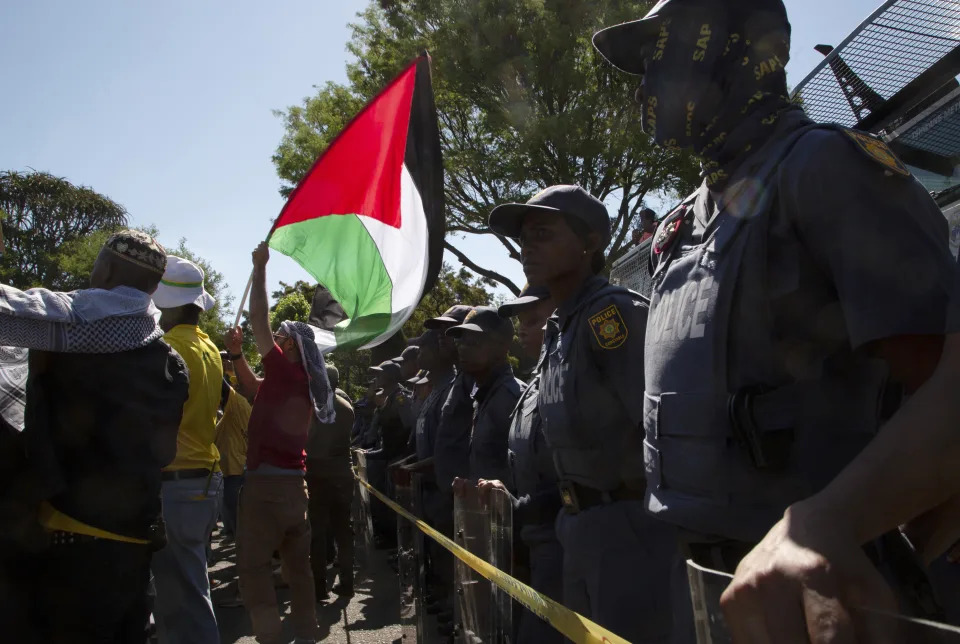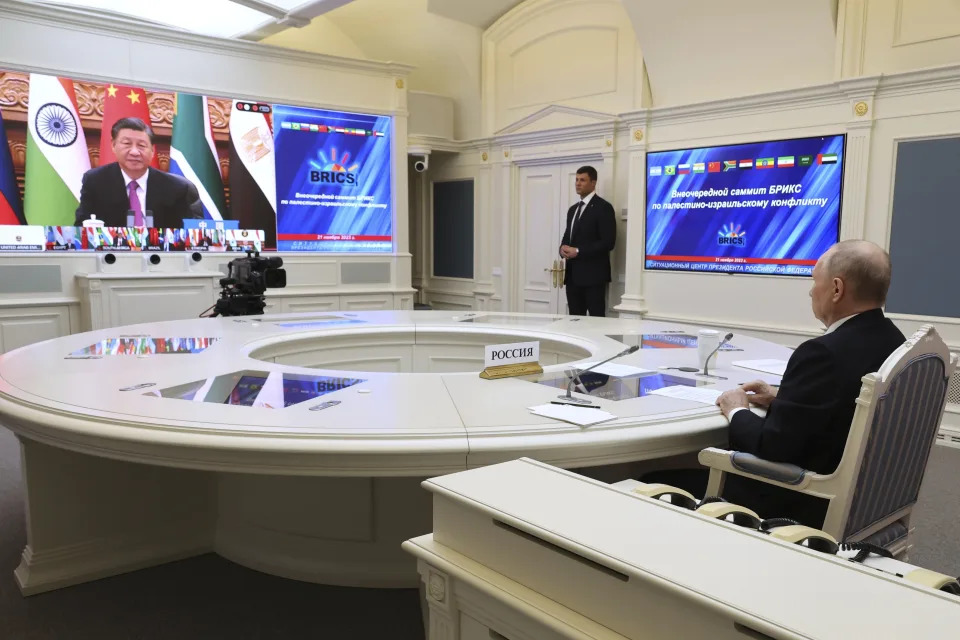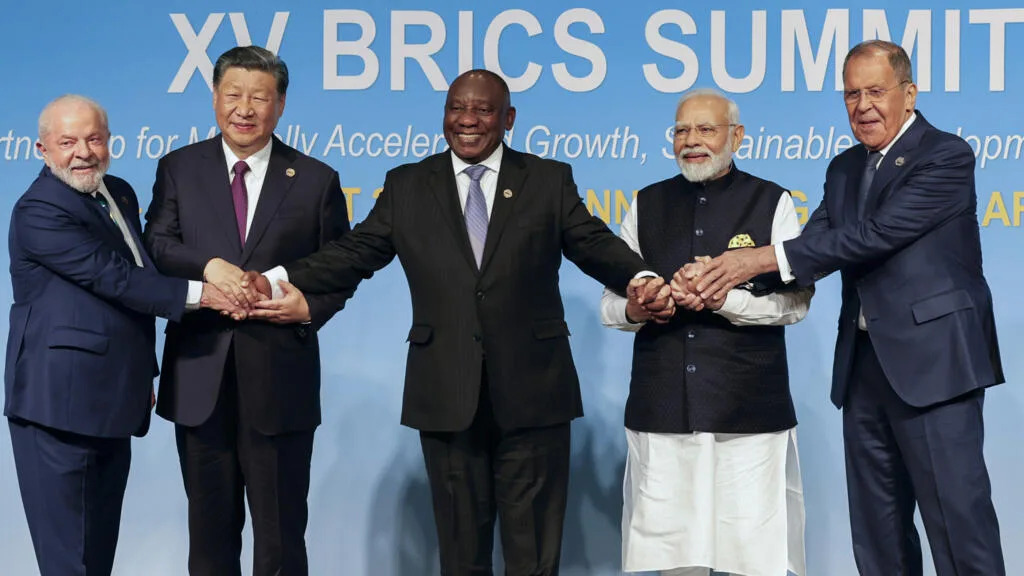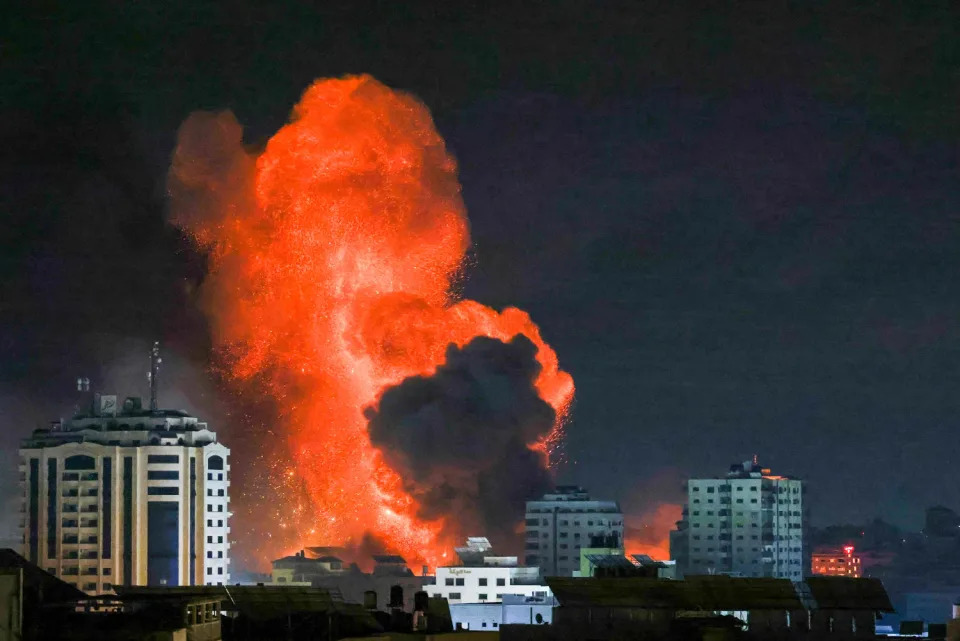South African lawmakers vote in favor of closing Israel's embassy and cutting diplomatic ties
ALL COUNTRIES WANTING A CEASEFIRE SHOULD DO THIS
MOGOMOTSI MAGOME
Updated Tue, November 21, 2023


Pro-Palestinian supporters demonstrate at the entrance to the Israeli embassy in Pretoria, South Africa, Friday, Oct. 20, 2023. Israel has recalled its ambassador to South Africa, Eliav Belotserkovsky, back to Jerusalem “for consultations” ahead of a parliamentary vote in the African country to decide the fate of the Israeli embassy. The two countries’ diplomatic relations have recently witnessed a rise in tensions over the Israeli war on Gaza which has killed thousands of people.
(AP Photo/Denis Farrell, File)
JOHANNESBURG (AP) — A majority of South African lawmakers on Tuesday voted in favor of a motion calling for the closure of the Israeli embassy and the cutting of diplomatic ties until Israel agrees to a cease-fire in Gaza.
The vote on the motion supported by the ruling African National Congress party came as President Cyril Ramaphosa in a meeting with other world leaders accused Israel of committing genocide in Gaza with its military offensive in the beseiged territory in search of its Hamas militant rulers.
The motion tabled by the opposition party Economic Freedom Fighters received the support of 248 parliament members while 91 lawmakers opposed it.
The vote came after Israel's foreign ministry said it had recalled its ambassador to South Africa, Eliav Belotserkovsky, back to Jerusalem “for consultations."
The two countries’ diplomatic relations have witnessed a rise in tensions over the war in Gaza. Ramaphosa previously said his country believes Israel is committing war crimes in Gaza, where thousands of Palestinians have been killed.
South Africa announced last week that it had referred what it called Israel’s “genocide” in Gaza to the International Criminal Court for an investigation. Its cabinet has called on the ICC to issue an arrest warrant against Israeli Prime Minister Benjamin Netanyahu.
Earlier this month, South Africa recalled its ambassador to Israel and withdrew all its diplomatic staff.
Ramaphosa's new comments Tuesday came in a virtual meeting of BRICS countries attended by leaders of the bloc including Russian President Vladimir Putin and Chinese President Xi Jinping.
The Israel-Hamas war began after the Palestinian militant group's surprise attacks on Israel on Oct.7 killed about 1,200 people. Israel's retaliatory strikes on Gaza have killed more than 12,700 people, according to Palestinian health authorities.
South African leader accuses Israel of war crimes. Putin and Xi strike more cautious note at meeting
JOHANNESBURG (AP) — A majority of South African lawmakers on Tuesday voted in favor of a motion calling for the closure of the Israeli embassy and the cutting of diplomatic ties until Israel agrees to a cease-fire in Gaza.
The vote on the motion supported by the ruling African National Congress party came as President Cyril Ramaphosa in a meeting with other world leaders accused Israel of committing genocide in Gaza with its military offensive in the beseiged territory in search of its Hamas militant rulers.
The motion tabled by the opposition party Economic Freedom Fighters received the support of 248 parliament members while 91 lawmakers opposed it.
The vote came after Israel's foreign ministry said it had recalled its ambassador to South Africa, Eliav Belotserkovsky, back to Jerusalem “for consultations."
The two countries’ diplomatic relations have witnessed a rise in tensions over the war in Gaza. Ramaphosa previously said his country believes Israel is committing war crimes in Gaza, where thousands of Palestinians have been killed.
South Africa announced last week that it had referred what it called Israel’s “genocide” in Gaza to the International Criminal Court for an investigation. Its cabinet has called on the ICC to issue an arrest warrant against Israeli Prime Minister Benjamin Netanyahu.
Earlier this month, South Africa recalled its ambassador to Israel and withdrew all its diplomatic staff.
Ramaphosa's new comments Tuesday came in a virtual meeting of BRICS countries attended by leaders of the bloc including Russian President Vladimir Putin and Chinese President Xi Jinping.
The Israel-Hamas war began after the Palestinian militant group's surprise attacks on Israel on Oct.7 killed about 1,200 people. Israel's retaliatory strikes on Gaza have killed more than 12,700 people, according to Palestinian health authorities.
South African leader accuses Israel of war crimes. Putin and Xi strike more cautious note at meeting
GERALD IMRAY
Updated Tue, November 21, 2023


South Africa BRICS Israel Palestinians
In this image made from video supplied by South Africa's Presidency, South African President Cyril Ramaphosa addresses BRICS leaders for a virtual meeting of leaders of developing countries Tuesday, Nov. 21, 2023. Ramaphosa accused Israel of war crimes, condemned Hamas for its attack on Israeli civilians that sparked the conflict and said both sides were guilty of violating international law.
(South Africa Presidency via AP Photo)
CAPE TOWN, South Africa (AP) — South African President Cyril Ramaphosa accused Israel of war crimes and acts “tantamount to genocide” in Gaza during a virtual meeting Tuesday of leaders of developing countries, including Russia's Vladimir Putin and China's Xi Jinping.
Ramaphosa also condemned Hamas for its attack on Israeli civilians that sparked the war in Gaza and said both sides were guilty of violating international law.
“The collective punishment of Palestinian civilians through the unlawful use of force by Israel is a war crime,” Ramaphosa said at the start of the meeting of leaders and top diplomats from the BRICS bloc of countries. “The deliberate denial of medicine, fuel, food and water to the residents of Gaza is tantamount to genocide.”
“In its attacks on civilians and by taking hostages, Hamas has also violated international law and must be held accountable for these actions,” Ramaphosa said.
Putin and Xi struck more cautious notes, calling for a cease-fire and the release of civilian hostages but not launching the same level of criticism of either side as Ramaphosa.
Also joining the meeting were leaders and officials from fellow BRICS members Brazil and India, and from Saudi Arabia, Argentina, Egypt, Ethiopia, Iran and the United Arab Emirates, which are set to join the bloc in January.
Ramaphosa chaired the “extraordinary meeting” and made the opening remarks because of South Africa's position as current chair of BRICS.
Putin said there was a “humanitarian catastrophe” unfolding in Gaza and it was “shocking to watch how surgeries are performed on children without anesthesia." He again blamed the crisis on what he called failed diplomacy by the United States.
“All these events, in fact, are a direct consequence of the U.S. desire to monopolize mediation functions in the Palestinian-Israeli settlement," Putin said while appearing on teleconference from the Kremlin. He called for a cease-fire in Gaza, the freeing of hostages and the evacuation of civilians from the Gaza Strip.
Putin's comments were in line with Russia's careful approach to the Israel-Hamas war, which may present an opportunity for it to advance its role as a global power broker. Putin proposed last month that Moscow could mediate in the conflict due to its relationships with both Israel and the Palestinians. He said Tuesday that the BRICS bloc could play “a key role” in finding a political settlement.
Putin has condemned the Oct. 7 attack by Hamas militants on towns in southern Israel that led to Israel’s offensive in Gaza, now in its seventh week, while warning Israel over its response and against blockading the Gaza Strip.
More than 11,000 Palestinians have been killed in Gaza, two-thirds of them women and minors, and more than 2,700 others are missing and believed to be buried under rubble, according to Gaza’s Health Ministry. The ministry says it has been unable to update its count since Nov. 11 because of the health sector’s collapse.
Gaza health officials say the toll has risen sharply since, and hospitals continue to report deaths from daily strikes, often dozens at a time.
The Health Ministry in the West Bank last reported a toll of 13,300 but stopped providing its own count Tuesday without giving a reason. Because of that, and because officials there declined to explain in detail how they tracked deaths after Nov. 11, the AP decided to stop reporting its count.
The Health Ministry toll does not differentiate between civilians and combatants. Israel says it has killed thousands of Hamas militants but has not provided evidence for its count.
Russia and China are leading voices in BRICS, which has largely cast itself in recent years as standing against the perceived dominance of the West in global affairs. But it has struggled to adopt united policies or positions on many issues because of the differing priorities of the five current members.
The meeting came a day after China’s top diplomat hosted the foreign ministers of Saudi Arabia, Egypt, Jordan, the Palestinian Authority and Indonesia in Beijing, their first stop on a tour of U.N. Security Council permanent members. That underlined China’s longstanding support for the Palestinians and its growing geopolitical influence.
India, which also wants to be seen as a leader of the developing world, has long walked a tightrope between Israel and the Palestinians and historically has close ties to both.
South Africa has been fiercely critical of Israel over the war in Gaza and had already filed a request with the International Criminal Court to investigate it over alleged war crimes. South Africa has for years compared Israel's policies in Gaza and the West Bank with its own past apartheid regime of racial segregation.
Ramaphosa called for the International Criminal Court to “urgently” initiate prosecutions against those responsible for what he termed war crimes on both sides and said South Africa also wants to see a cease-fire and the deployment of a U.N. force to monitor the cease-fire.
Later Tuesday, a large majority of South African lawmakers voted in favor of a motion to shut down the Israeli Embassy and cut diplomatic ties with Israel until it agrees to a cease-fire in Gaza. Israel had recalled its ambassador for consultations before the vote took place.
___
AP Israel-Hamas war coverage: https://apnews.com/hub/israel-hamas-war
How Israel-South Africa Relations Fell Apart Over Gaza
CAPE TOWN, South Africa (AP) — South African President Cyril Ramaphosa accused Israel of war crimes and acts “tantamount to genocide” in Gaza during a virtual meeting Tuesday of leaders of developing countries, including Russia's Vladimir Putin and China's Xi Jinping.
Ramaphosa also condemned Hamas for its attack on Israeli civilians that sparked the war in Gaza and said both sides were guilty of violating international law.
“The collective punishment of Palestinian civilians through the unlawful use of force by Israel is a war crime,” Ramaphosa said at the start of the meeting of leaders and top diplomats from the BRICS bloc of countries. “The deliberate denial of medicine, fuel, food and water to the residents of Gaza is tantamount to genocide.”
“In its attacks on civilians and by taking hostages, Hamas has also violated international law and must be held accountable for these actions,” Ramaphosa said.
Putin and Xi struck more cautious notes, calling for a cease-fire and the release of civilian hostages but not launching the same level of criticism of either side as Ramaphosa.
Also joining the meeting were leaders and officials from fellow BRICS members Brazil and India, and from Saudi Arabia, Argentina, Egypt, Ethiopia, Iran and the United Arab Emirates, which are set to join the bloc in January.
Ramaphosa chaired the “extraordinary meeting” and made the opening remarks because of South Africa's position as current chair of BRICS.
Putin said there was a “humanitarian catastrophe” unfolding in Gaza and it was “shocking to watch how surgeries are performed on children without anesthesia." He again blamed the crisis on what he called failed diplomacy by the United States.
“All these events, in fact, are a direct consequence of the U.S. desire to monopolize mediation functions in the Palestinian-Israeli settlement," Putin said while appearing on teleconference from the Kremlin. He called for a cease-fire in Gaza, the freeing of hostages and the evacuation of civilians from the Gaza Strip.
Putin's comments were in line with Russia's careful approach to the Israel-Hamas war, which may present an opportunity for it to advance its role as a global power broker. Putin proposed last month that Moscow could mediate in the conflict due to its relationships with both Israel and the Palestinians. He said Tuesday that the BRICS bloc could play “a key role” in finding a political settlement.
Putin has condemned the Oct. 7 attack by Hamas militants on towns in southern Israel that led to Israel’s offensive in Gaza, now in its seventh week, while warning Israel over its response and against blockading the Gaza Strip.
More than 11,000 Palestinians have been killed in Gaza, two-thirds of them women and minors, and more than 2,700 others are missing and believed to be buried under rubble, according to Gaza’s Health Ministry. The ministry says it has been unable to update its count since Nov. 11 because of the health sector’s collapse.
Gaza health officials say the toll has risen sharply since, and hospitals continue to report deaths from daily strikes, often dozens at a time.
The Health Ministry in the West Bank last reported a toll of 13,300 but stopped providing its own count Tuesday without giving a reason. Because of that, and because officials there declined to explain in detail how they tracked deaths after Nov. 11, the AP decided to stop reporting its count.
The Health Ministry toll does not differentiate between civilians and combatants. Israel says it has killed thousands of Hamas militants but has not provided evidence for its count.
Russia and China are leading voices in BRICS, which has largely cast itself in recent years as standing against the perceived dominance of the West in global affairs. But it has struggled to adopt united policies or positions on many issues because of the differing priorities of the five current members.
The meeting came a day after China’s top diplomat hosted the foreign ministers of Saudi Arabia, Egypt, Jordan, the Palestinian Authority and Indonesia in Beijing, their first stop on a tour of U.N. Security Council permanent members. That underlined China’s longstanding support for the Palestinians and its growing geopolitical influence.
India, which also wants to be seen as a leader of the developing world, has long walked a tightrope between Israel and the Palestinians and historically has close ties to both.
South Africa has been fiercely critical of Israel over the war in Gaza and had already filed a request with the International Criminal Court to investigate it over alleged war crimes. South Africa has for years compared Israel's policies in Gaza and the West Bank with its own past apartheid regime of racial segregation.
Ramaphosa called for the International Criminal Court to “urgently” initiate prosecutions against those responsible for what he termed war crimes on both sides and said South Africa also wants to see a cease-fire and the deployment of a U.N. force to monitor the cease-fire.
Later Tuesday, a large majority of South African lawmakers voted in favor of a motion to shut down the Israeli Embassy and cut diplomatic ties with Israel until it agrees to a cease-fire in Gaza. Israel had recalled its ambassador for consultations before the vote took place.
___
AP Israel-Hamas war coverage: https://apnews.com/hub/israel-hamas-war
How Israel-South Africa Relations Fell Apart Over Gaza
Armani Syed
TIME
Tue, November 21, 2023

Supporters during the ANC KZN Palestinian Solidarity March on Oct. 26, 2023 in Durban, South Africa. The group is standing in solidarity with the Palestinian resistance against Israeli and over the war in the Gaza Strip.
Tue, November 21, 2023

Supporters during the ANC KZN Palestinian Solidarity March on Oct. 26, 2023 in Durban, South Africa. The group is standing in solidarity with the Palestinian resistance against Israeli and over the war in the Gaza Strip.
Credit - Darren Stewart—Gallo Images / Getty Images
Israel has recalled its ambassador, Eliav Belotserkovsky, to South Africa “for consultations,” as the African nation prepares to host a summit for world leaders and a vote on whether to shut down its Israeli embassy and sever diplomatic ties.
Belotserkovsky has been called to Jerusalem amid South African President Cyril Ramaphosa’s criticism of Israel’s attacks on Gaza, according to Israel’s foreign ministry. “Following the latest South African statements, the Ambassador of Israel to Pretoria has been recalled to Jerusalem for consultations,” Israel’s ministry of foreign affairs posted late Monday on X.
South Africa has been vocal in reprimanding Israel’s bombardment of Gaza and filed a referral to the International Criminal Court, seeking an investigations into what Ramaphosa has described as Israel’s “war crimes” and “tantamount to genocide.”
Earlier in November, South Africa also recalled its ambassador to Israel and withdrew its diplomatic presence on the ground.
“Given that much of the global community is witnessing the commission of these crimes in real time, including statements of genocidal intent by many Israeli leaders, we expect that warrants of arrest for these leaders, including Prime Minister Benjamin Netanyahu, should be issued shortly,” South African minister in the presidency, Khumbudzo Ntshavheni, also told reporters on Monday.
South African diplomats have long identified likeness between life for Palestinians under occupation and those who lived under apartheid, the legal system for racial separation in South Africa from 1948 until 1994.
In July 2022, over a year before Hamas’ attacks on Oct. 7, South African diplomat Nalendi Pandor said, “For many South Africans, the narrative of the Palestinian people's struggle does evoke experiences of our own history of racial segregation and oppression."
Israel began striking the Palestinian enclave in response to Hamas attacks, in which 1,200 were killed and around 240 taken hostage.. Since then, at least 13,000 Gazans have died, among them thousands of children, U.N. workers, and journalists. At least 1.4 million people of Gaza’s 2.2 million population have been displaced by the war.
Ramaphosa’s ruling African National Congress party, among other smaller parties, will support a motion brought about by leftist opposition party Economic Freedom Fighters to close Israel’s embassy in the nation. South Africa’s parliament is set to vote on the matter Tuesday, which would take effect until Israel agrees to a ceasefire in Gaza and further negotiations carried out by the U.N.
The move comes just as South Africa prepares to host a virtual summit with the BRICS, an economic bloc of nations (Brazil, Russia, India, China, and South Africa) to discuss Israel’s war on Gaza. Iran, Egypt, Ethiopia, Saudi Arabia, and the United Arab Emirates, will also join the group in January.
Among the leaders attending are Russian President Vladimir Putin, Indian Prime Minister Narendra Modi and Chinese President Xi Jinping, who has expressed his support for Palestinians and welcomed diplomats from Arab and Muslim nations in Beijing Monday.
More From TIME
Russia and India have taken a strategic approach to the conflict, keeping in mind longer term aims.
Putin has been accused of using the conflict to his political advantage, placing the blame with the U.S. "I think that many will agree with me that this is a clear example of the failed policy in the Middle East of the United States, which tried to monopolize the settlement process," Putin told Iraq's prime minister on Oct. 10. He offered condolences to Israel on the loss of lives six days after the attack, but said a Hamas delegation was in Moscow for talks on Oct. 17.
At the time of the Hamas attacks, Modi expressed “complete solidarity” with Israel. While Modi has since “strongly condemned” civilian deaths in the war, India also abstained from a U.N. assembly vote on a “humanitarian truce” on Oct. 27.
Ramaphosa is set to chair a meeting where leaders will deliver statements on Gaza’s humanitarian crisis, after which a joint statement will likely follow.
Write to Armani Syed at armani.syed@time.com.
South Africa to chair emergency BRICS summit on Gaza crisis
Israel has recalled its ambassador, Eliav Belotserkovsky, to South Africa “for consultations,” as the African nation prepares to host a summit for world leaders and a vote on whether to shut down its Israeli embassy and sever diplomatic ties.
Belotserkovsky has been called to Jerusalem amid South African President Cyril Ramaphosa’s criticism of Israel’s attacks on Gaza, according to Israel’s foreign ministry. “Following the latest South African statements, the Ambassador of Israel to Pretoria has been recalled to Jerusalem for consultations,” Israel’s ministry of foreign affairs posted late Monday on X.
South Africa has been vocal in reprimanding Israel’s bombardment of Gaza and filed a referral to the International Criminal Court, seeking an investigations into what Ramaphosa has described as Israel’s “war crimes” and “tantamount to genocide.”
Earlier in November, South Africa also recalled its ambassador to Israel and withdrew its diplomatic presence on the ground.
“Given that much of the global community is witnessing the commission of these crimes in real time, including statements of genocidal intent by many Israeli leaders, we expect that warrants of arrest for these leaders, including Prime Minister Benjamin Netanyahu, should be issued shortly,” South African minister in the presidency, Khumbudzo Ntshavheni, also told reporters on Monday.
South African diplomats have long identified likeness between life for Palestinians under occupation and those who lived under apartheid, the legal system for racial separation in South Africa from 1948 until 1994.
In July 2022, over a year before Hamas’ attacks on Oct. 7, South African diplomat Nalendi Pandor said, “For many South Africans, the narrative of the Palestinian people's struggle does evoke experiences of our own history of racial segregation and oppression."
Israel began striking the Palestinian enclave in response to Hamas attacks, in which 1,200 were killed and around 240 taken hostage.. Since then, at least 13,000 Gazans have died, among them thousands of children, U.N. workers, and journalists. At least 1.4 million people of Gaza’s 2.2 million population have been displaced by the war.
Ramaphosa’s ruling African National Congress party, among other smaller parties, will support a motion brought about by leftist opposition party Economic Freedom Fighters to close Israel’s embassy in the nation. South Africa’s parliament is set to vote on the matter Tuesday, which would take effect until Israel agrees to a ceasefire in Gaza and further negotiations carried out by the U.N.
The move comes just as South Africa prepares to host a virtual summit with the BRICS, an economic bloc of nations (Brazil, Russia, India, China, and South Africa) to discuss Israel’s war on Gaza. Iran, Egypt, Ethiopia, Saudi Arabia, and the United Arab Emirates, will also join the group in January.
Among the leaders attending are Russian President Vladimir Putin, Indian Prime Minister Narendra Modi and Chinese President Xi Jinping, who has expressed his support for Palestinians and welcomed diplomats from Arab and Muslim nations in Beijing Monday.
More From TIME
Russia and India have taken a strategic approach to the conflict, keeping in mind longer term aims.
Putin has been accused of using the conflict to his political advantage, placing the blame with the U.S. "I think that many will agree with me that this is a clear example of the failed policy in the Middle East of the United States, which tried to monopolize the settlement process," Putin told Iraq's prime minister on Oct. 10. He offered condolences to Israel on the loss of lives six days after the attack, but said a Hamas delegation was in Moscow for talks on Oct. 17.
At the time of the Hamas attacks, Modi expressed “complete solidarity” with Israel. While Modi has since “strongly condemned” civilian deaths in the war, India also abstained from a U.N. assembly vote on a “humanitarian truce” on Oct. 27.
Ramaphosa is set to chair a meeting where leaders will deliver statements on Gaza’s humanitarian crisis, after which a joint statement will likely follow.
Write to Armani Syed at armani.syed@time.com.
South Africa to chair emergency BRICS summit on Gaza crisis
Melissa Chemam with RFI
Tue, November 21, 2023

AP - Gianluigi Guercia
Tuesday's virtual meeting will be hosted by South African President Cyril Ramaphosa in the hope of drawing up a common response to the Israel - Hamas conflict, now entering its seventh week.
"Leaders of the BRICS countries - Brazil, Russia, India and China - will gather [under the South African presidency] for an emergency virtual meeting, inviting the leaders of the [new] BRICS countries - Saudi Arabia, Argentina, Egypt, Ethiopia, Iran and the United Arab Emirates," the South African president’s office said in a statement.
Hosted by President Cyril Ramaphosa, the members will discuss the situation in the Middle East, including the Gaza Strip.
South Africa said United Nations Secretary General Antonio Guterres would take part in the virtual meeting, and that it was expected to end with a joint statement.
The meeting comes days after leaders from the APEC group, which includes China and the United States, failed to agree on a joint response to the Israel - Hamas war.
Criticism
China's President Xi Jinping and Russian President Vladimir Putin have both confirmed that they will take part in the virtual summit.
Russia has maintained historically close ties with both Israel and the Palestinians, and Putin has said Russia could play a mediating role.
Putin has criticised the West for allegedly stoking tensions in the region and Israel for its conduct in the conflict.
South Africa calls for UN force to protect civilians in Gaza
China has historically been sympathetic to the Palestinians and supportive of a two-state solution to the Israeli-Palestinian conflict.
Read more on RFI English












